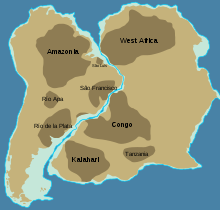Amazonian Craton: Difference between revisions
Sietecolores (talk | contribs) mNo edit summary |
Tom.Reding (talk | contribs) m →top: Fix Category:Pages using citations with accessdate and no URL when permanent identifier present using AWB |
||
| Line 4: | Line 4: | ||
The '''Amazonian Craton''' is a [[geologic province]] located in [[South America]]. It occupies a large portion of the central, north and eastern part of the continent. The [[Guiana Shield]] and Central Brazil Shield (Guaporé Shield) constitutes respectively the northern and southern [[exhumation (geology)|exhumed]] parts of the craton. Between the two shields lies the [[Amazon Basin (sedimentary basin)|Amazon Rift]], a zone of weakness within the craton. Smaller cratons of [[Precambrian]] rocks south of the Amazonian Shield are the [[Río de la Plata Craton]] and the [[São Francisco Craton]], which lies to the east. |
The '''Amazonian Craton''' is a [[geologic province]] located in [[South America]]. It occupies a large portion of the central, north and eastern part of the continent. The [[Guiana Shield]] and Central Brazil Shield (Guaporé Shield) constitutes respectively the northern and southern [[exhumation (geology)|exhumed]] parts of the craton. Between the two shields lies the [[Amazon Basin (sedimentary basin)|Amazon Rift]], a zone of weakness within the craton. Smaller cratons of [[Precambrian]] rocks south of the Amazonian Shield are the [[Río de la Plata Craton]] and the [[São Francisco Craton]], which lies to the east. |
||
It has been suggested that the [[Mesoproterozoic|Late Mesoproterozoic]]–[[Neoproterozoic|Early Neoproterozoic]] aged [[Sveconorwegian orogeny|Sveconorwegian Orogen]] in [[Fennoscandia]] could have been caused by a [[Continental collision|continent–continent collision]] between the Amazonia and [[Baltica]].<ref name=Slagstadetal2013>{{cite journal |last=Slagstad |first=Trond |last2=Roberts |first2=Nick M. W.|last3=Markens |first3=Rogens |last4=Røhr |first4=Torkil|last5=Schiellerup |first5=Henrik |date=2013 |title=A non-collisional, accretionary Sveconorwegian orogen |url= |journal=[[Terra Nova (journal)|Terra Nova]] |publisher= |volume=25 |issue= |pages=30–37 |doi= 10.1111/ter.12001|access-date=22 August 2015 |
It has been suggested that the [[Mesoproterozoic|Late Mesoproterozoic]]–[[Neoproterozoic|Early Neoproterozoic]] aged [[Sveconorwegian orogeny|Sveconorwegian Orogen]] in [[Fennoscandia]] could have been caused by a [[Continental collision|continent–continent collision]] between the Amazonia and [[Baltica]].<ref name=Slagstadetal2013>{{cite journal |last=Slagstad |first=Trond |last2=Roberts |first2=Nick M. W.|last3=Markens |first3=Rogens |last4=Røhr |first4=Torkil|last5=Schiellerup |first5=Henrik |date=2013 |title=A non-collisional, accretionary Sveconorwegian orogen |url= |journal=[[Terra Nova (journal)|Terra Nova]] |publisher= |volume=25 |issue= |pages=30–37 |doi= 10.1111/ter.12001}}<!--|access-date=22 August 2015--></ref> The question is open if Telemarkia [[terrane]] in [[Norway]] was derived from the Amazonian Craton but this possibility does not imply necessarily that there was a continental collision.<ref name=Bingenetal2008>{{cite journal |last=Bingen |first=Bernard |last2=Nordgulen |first2=Øystein|last3=Viola |first3=Giulio |date=2008 |title=A four-phase model for the Sveconorwegian orogeny, SW Scandinavia |url= |journal=[[Norwegian Journal of Geology]] |publisher= |volume=88 |issue= |pages=43–72 |doi= |access-date=22 August 2015}}</ref> |
||
The Río Apa Craton at the [[Paraguay]]-Brazil border is considered be likely just the southern part of the Amazonian Craton.<ref name=Gaucher2010-137>{{cite book |
The Río Apa Craton at the [[Paraguay]]-Brazil border is considered be likely just the southern part of the Amazonian Craton.<ref name=Gaucher2010-137>{{cite book |
||
| Line 16: | Line 16: | ||
|editor2-last=Sial |editor2-first=Alcides |
|editor2-last=Sial |editor2-first=Alcides |
||
|editor3-last=Haverson |editor3-first=Galen |
|editor3-last=Haverson |editor3-first=Galen |
||
|url= |location= |publisher=Elsevier |page=258 |isbn=|doi=10.1016/S0166-2635(09)01619-3}}</ref> The rocks of Río Apa were deformed during the [[Sunsás orogeny]].<ref>{{cite journal |last=Tohver |first=E. |last2=Trindade |first2=R.I.F. |last3=Solum |first3=G.F. |last4=Hall |first4=C.M. |last5=Riccomini |first5=C. |last6=Nogueira |first6=A.C. |date=2010 |title=Closing the Clymene ocean and bending a Brasiliano belt: Evidence for the Cambrian formation of Gondwana, southeast Amazon craton |url= |journal=[[Geology (journal)|Geology]] |publisher= |volume=38 |issue= |pages=267–270 |doi=10.1130/G30510.1 |access-date=21 January 2016 |
|url= |location= |publisher=Elsevier |page=258 |isbn=|doi=10.1016/S0166-2635(09)01619-3}}</ref> The rocks of Río Apa were deformed during the [[Sunsás orogeny]].<ref>{{cite journal |last=Tohver |first=E. |last2=Trindade |first2=R.I.F. |last3=Solum |first3=G.F. |last4=Hall |first4=C.M. |last5=Riccomini |first5=C. |last6=Nogueira |first6=A.C. |date=2010 |title=Closing the Clymene ocean and bending a Brasiliano belt: Evidence for the Cambrian formation of Gondwana, southeast Amazon craton |url= |journal=[[Geology (journal)|Geology]] |publisher= |volume=38 |issue= |pages=267–270 |doi=10.1130/G30510.1 }}<!--|access-date=21 January 2016--></ref> |
||
==See also== |
==See also== |
||
Revision as of 14:32, 9 June 2016

The Amazonian Craton is a geologic province located in South America. It occupies a large portion of the central, north and eastern part of the continent. The Guiana Shield and Central Brazil Shield (Guaporé Shield) constitutes respectively the northern and southern exhumed parts of the craton. Between the two shields lies the Amazon Rift, a zone of weakness within the craton. Smaller cratons of Precambrian rocks south of the Amazonian Shield are the Río de la Plata Craton and the São Francisco Craton, which lies to the east.
It has been suggested that the Late Mesoproterozoic–Early Neoproterozoic aged Sveconorwegian Orogen in Fennoscandia could have been caused by a continent–continent collision between the Amazonia and Baltica.[1] The question is open if Telemarkia terrane in Norway was derived from the Amazonian Craton but this possibility does not imply necessarily that there was a continental collision.[2]
The Río Apa Craton at the Paraguay-Brazil border is considered be likely just the southern part of the Amazonian Craton.[3] The rocks of Río Apa were deformed during the Sunsás orogeny.[4]
See also
References
- Zandt, George (Spring 2002). "Orogenic Systems: The Andes". University of Arizona.
- ^ Slagstad, Trond; Roberts, Nick M. W.; Markens, Rogens; Røhr, Torkil; Schiellerup, Henrik (2013). "A non-collisional, accretionary Sveconorwegian orogen". Terra Nova. 25: 30–37. doi:10.1111/ter.12001.
- ^ Bingen, Bernard; Nordgulen, Øystein; Viola, Giulio (2008). "A four-phase model for the Sveconorwegian orogeny, SW Scandinavia". Norwegian Journal of Geology. 88: 43–72.
{{cite journal}}:|access-date=requires|url=(help) - ^ Mantovani, Marta S.M.; de Brito Neves, Benjamin B. (2010). "The Paranapanema Lithospheric Block: Its Nature and Role in the Accretion of Gondwana". In Gaucher, Claudio; Sial, Alcides; Haverson, Galen (eds.). Neoproterozoic-Cambrian tectonics, global change and evolution: a focus on south western Gondwana. Elsevier. p. 258. doi:10.1016/S0166-2635(09)01619-3.
- ^ Tohver, E.; Trindade, R.I.F.; Solum, G.F.; Hall, C.M.; Riccomini, C.; Nogueira, A.C. (2010). "Closing the Clymene ocean and bending a Brasiliano belt: Evidence for the Cambrian formation of Gondwana, southeast Amazon craton". Geology. 38: 267–270. doi:10.1130/G30510.1.

